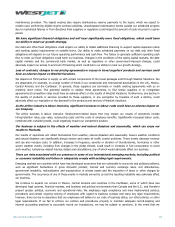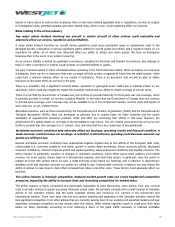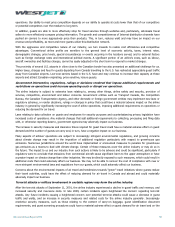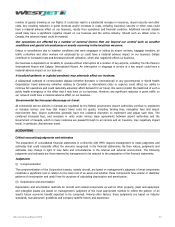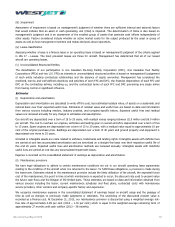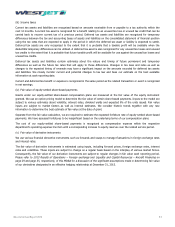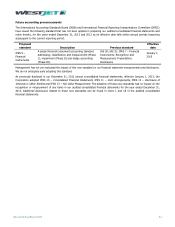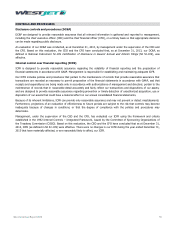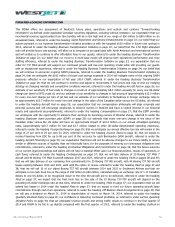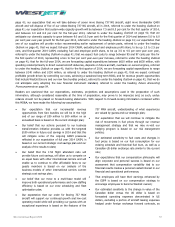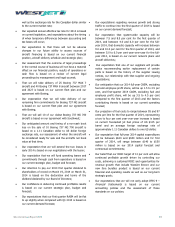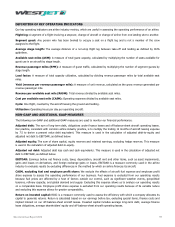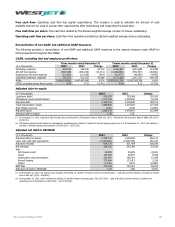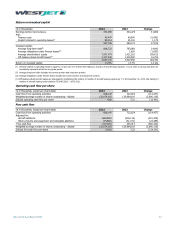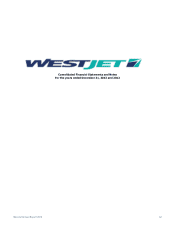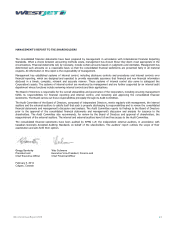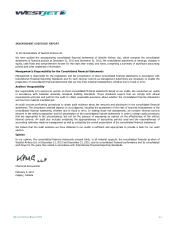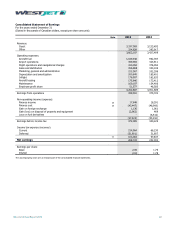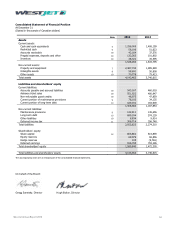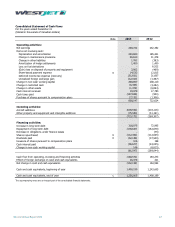Westjet 2013 Annual Report Download - page 57
Download and view the complete annual report
Please find page 57 of the 2013 Westjet annual report below. You can navigate through the pages in the report by either clicking on the pages listed below, or by using the keyword search tool below to find specific information within the annual report.
WestJet Annual Report 2013 57
page 41; our expectation that we will take delivery of seven more Boeing 737 NG aircraft, eight more Bombardier Q400
aircraft and will dispose of five of our oldest Boeing 737 NG aircraft, all in 2014, referred to under the heading
Outlook
on
page 41; our expectation that system-wide capacity growth will be between 7.5 and 8.5 per cent for the first quarter of 2014,
and between 4.0 and 6.0 per cent for the full-year 2014, referred to under the heading
Outlook
on page 41; that we
anticipate our domestic capacity to grow between 9.0 and 10.0 per cent for the first quarter of 2014 and between 5.0 to 6.0
per cent year-over-year growth for the full-year 2014, referred to under the heading
Outlook
on page 41; our expectation that
one of our suppliers will provide notice recommending earlier replacement of certain parts, referred to under the heading
Outlook
on page 41; that we expect full-year 2014 CASM, excluding fuel and employee profit share, to be up 1.5 to 2.5 per
cent, and first-quarter 2014 CASM, excluding fuel and employee profit share, to be up 3.5 to 4.5 per cent year over year,
referred to under the heading
Outlook
on page 41; that we expect fuel costs to range between 95 and 97 cents per litre for
the first quarter of 2014, representing a two to four per cent year-over-year increase, referred to under the heading
Outlook
on page 41; that for the full-year 2014, we are forecasting capital expenditures between $610 million and $630 million, with
spending related primarily to direct owned aircraft deliveries, deposits on future aircraft, overhauls on owned engines, referred
to under the heading
Outlook
on page 41; that for the first quarter of 2014, we are forecasting capital expenditures to range
between $140 million and $150 million, as referred to under the heading
Outlook
on page 41; that we expect continued
profitable growth driven by controlling our costs, achieving a sustained long-term ROIC, and for revenue growth opportunities
that include WestJet Encore and our new fare bundles product, referred to under the heading
Outlook
on page 41; that we do
not anticipate early adopting the new financial instrument standard, referred to under the heading
Future Accounting
Pronouncements
on page 54.
Readers are cautioned that our expectations, estimates, projections and assumptions used in the preparation of such
information, although considered reasonable at the time of preparation, may prove to be imprecise and, as such, undue
reliance should not be placed on forward-looking statements. With respect to forward-looking information contained within
this MD&A, we have made the following key assumptions:
Our expectation that our incremental revenue
opportunities from fare bundles we will be in the high
end of our range of $50 million to $80 million on an
annualized basis is based on the current strategic plan;
Our belief that our actions pursuant to our business
transformation initiative provides us with the targeted
$100 million in future cost savings in 2014 and that this
will mitigate some of the ongoing CASM pressures
reflected in our expectation of full year 2014 CASM, is
based on our current strategic cost savings plan and our
analysis of the results to date;
Our belief that the 1:50 flight attendant ratio will
provide future cost savings, will allow us to compete on
an equal basis with other international carriers and will
enable us to continue to offer affordable fares to our
guests members is based on our analysis of the
business models of other international carriers current
strategic cost savings plan;
our belief that our move to a multi-base model will
improve both operational performance and crew staffing
efficiency is based on our crew scheduling and fleet
optimization plan;
Our expectation that our order for Boeing 737 MAX
aircraft will support our continued growth and low-cost
operating model while still providing our guests with an
exceptional experience is based on the features of the
737 MAX aircraft, understanding of what experiences
are valued by guests and our strategic plan;
Our expectation that we will continue to mitigate the
risk of movements in fuel prices through our revenue
management strategy and that we may re-visit our
hedging program is based on our risk management
policies;
Our estimated sensitivity to fuel costs and changes in
fuel prices is based on our fuel consumption for our
existing schedule and historical fuel burn, as well as a
Canadian-US dollar exchange rate similar to the current
rate;
Our expectations that our compensation philosophy will
align corporate and personal success is based on our
assessment that compensation variability tied to our
financial results creates a personal vested interest in our
financial and operational performance;
That employees will have their earnings enhanced by
the ESPP is based on our compensation strategy to
encourage employees to become WestJet owners;
Our estimated sensitivity to the change in value of the
Canadian dollar versus the US dollar is based on
forecasted operating expenses denominated in US
dollars, excluding a portion of aircraft leasing expenses
hedged under foreign exchange forward contracts, as



